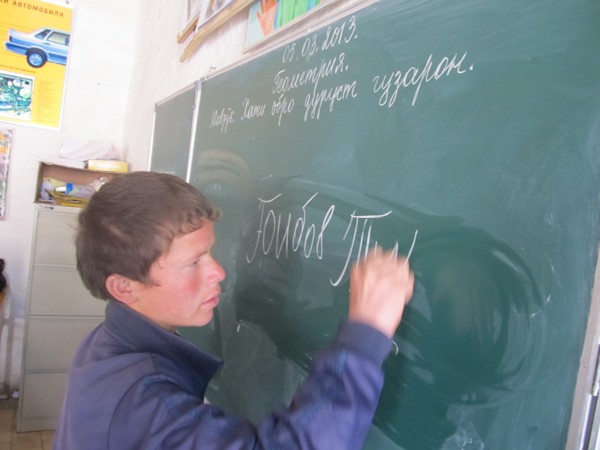
“I wanted to drop out of school because I couldn’t read and write. I thought quitting was the easiest thing to do,” said Tillo Ghoibov, a ninth-grader in the Vose district of Tajikistan.
Tillo’s father and older brothers go daily in search of work while his mother tends to their household of 10 children. “We have a hard life,” said his mother. “Frankly, I am uneducated, so I cannot help my children with their homework. Tillo couldn’t read and write, and we wanted to take him out of school.”
Students in Tajikistan leave school for a range of reasons. Their families cannot pay for school-related expenses, or they rely heavily on their children to work or help around the house. Sometimes, students like Tillo simply miss too much school, fall behind and become discouraged.
Tajikistan’s school dropout rate is relatively low across all grades. However, dropout rates spike during (11 percent) and after (22 percent) grade nine—the end of the compulsory education cycle. The USAID Student Motivation Learning Program aims to reduce those rates by identifying students who are at risk of dropping out, providing them extra academic support and encouragement, and strengthening schools’ capacity to track students’ progress and communicate closely with their families.
In October 2012, Tillo began attending the after-school program, where tutors teach supplementary lessons in core subjects. His reading and writing skills improved quickly. The program’s hands-on, interactive approach and games provide Tillo additional incentive to attend. Today, he is more confident in class and eager to study.
Meanwhile, the school closely tracked Tillo’s attendance and grades and began communicating more closely with Tillo’s parents about his challenges and progress. Tillo’s mother met with teachers and program staff to learn what she could do at home to support her children to do better in school.
“The program’s impact is very noticeable," said Abdulhakim Sattarov, the principal at Tillo’s school #31. "Tillo’s teachers are happy with his accomplishments. Tillo is now active not only in the after-school tutoring program, but also more active in his regular classes.”
Now, Tillo plans to finish secondary school so he can continue his studies and become a teacher himself. He is one of 1,500 students that USAID reached through the Student Motivation Learning program in Tajikistan during the 2012-2013 school year.
The program, which runs from September 2010 to Sept 2015, is currently being assessed in India, Cambodia and Timor Leste. It provides evidence-based programming guidance to the Government of Tajikistan by piloting and testing strategies to retain students.







Comment
Make a general inquiry or suggest an improvement.